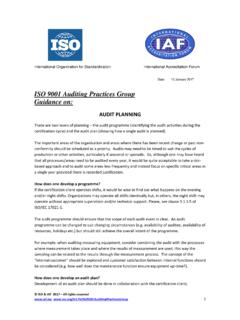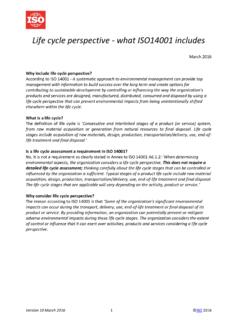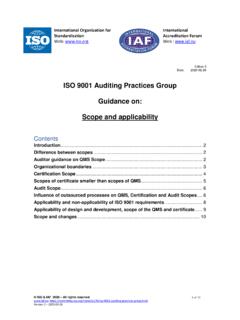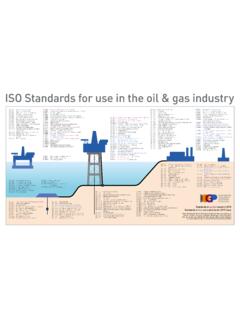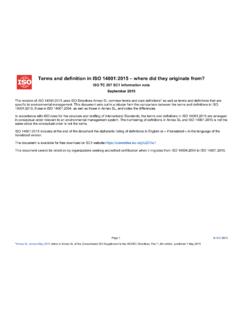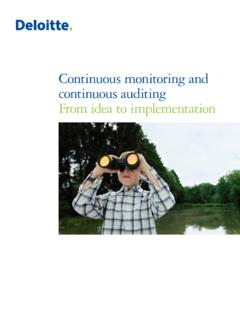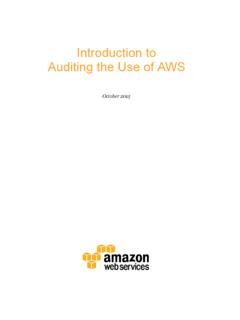Transcription of ISO 9001 Auditing Practices Group Guidance on
1 International Organization for Standardization International Accreditation Forum Date: 13 January 2016. ISO 9001 Auditing Practices Group Guidance on: Design and Development Process 1. Introduction The objective of Auditing the design and development process is to determine whether it is managed and controlled to enable products and services to meet their intended use and specified requirements. It is necessary to note that for service organizations, the approach to design and development may be different from traditional manufacturing organizations (see the ISO. 9001 Auditing Practices Group Guidance document on Service Organizations ). Before discussing in detail the way in which the design and development process should be audited it is vital for the auditor to understand what is meant by the phrase Design and development.
2 By misunderstanding this concept, many organizations have wrongly excluded this process from their quality management system. ISO 9001clause refers only to design and development of products and services. In some organizations it can be beneficial, but not required, to apply the same methodology to design and development of processes. Product and service design and development is the set of processes for transforming requirements for the products and services (for example specifications, statutory requirements and specific or implied customer requirements) into specified product/ service characteristics ( distinguishing features of the product ). ISO 9000 Clause gives the following examples of characteristics: physical ( mechanical, electrical, chemical or biological characteristics);. sensory ( related to smell, touch, taste, sight, hearing).
3 Behavioural ( courtesy, honesty, veracity);. temporal ( punctuality, reliability, availability, continuity);. ISO & IAF 2009 All rights reserved 1. ; ergonomic ( physiological characteristic, or related to human safety);. functional ( maximum speed of an aircraft). In order for to determine if the organization is in fact involved in design and development, auditors need to establish who is responsible for defining the characteristics of the product or service, together with how and when this is carried out. This may apply to original design or ongoing design changes. Generally, the design and development process consists of the stages shown in Figure 1. below. Each stage has specific deliverables that cover both the commercial and technical aspects of design and development of a product or service.
4 In some cases, organisations might be able to justify the exclusion of certain sub-clauses or individual requirements from their QMS, without necessarily excluding the entire clause. For an organisation with a long established and well validated product/service design, for example, the organisation might only need to ensure that design changes are managed in accordance with the requirements of clause Auditors should verify that any claims of non-applicability are valid (see ISO. 9001 Auditing Practices Group paper on scope ). Need for products, services and processes identified D. Design and development planning E. ISO 9001 S. I. G. N. Design and development inputs Design and develop- ISO 9001 ment changes R. ISO 9001 E. V. Design and development process I. E. W. ISO 9001. Design and development controls (verification) Design and development outputs ISO 9001 ISO 9001 (Design and de- velop- ment Design and development controls (validation) Controls ISO 9001 Completed design or development Figure 1 Outline of the Design and Development Process Auditors should establish what design and development projects have been, and are currently being, undertaken.)
5 Auditors should select a sufficient number of projects to be able to audit all stages of the design process. Guidance for Auditing the various stages of the design and development process is given below but it should be noted that it might not be possible to audit all stages for all the projects selected. ISO & IAF 2009 All rights reserved 2. ; 2. Auditing the need for design and development The need for design and development comes from an organization's context and the application of risk based thinking. Auditors may also review that an organization has considered the following sources: customer requirements the organization's strategic intent;. market intelligence and research;. service reports;. customer feedback;. new or changed statutory and regulatory requirements;. process changes;. new technology.
6 Suppliers. Auditors should evaluate whether the organization has in place, and performs, activities for the review of such needs. Auditors should review how the decision to proceed with design and development is taken, have risks and opportunities, including cost implications, been considered and have all relevant interested parties (internal or external) been consulted. 3. Auditing design and development planning The following issues should be considered when Auditing the planning function: what is the overall flow of the design planning process? how is it described? what resources and competencies are required? what part of the design will be outsourced? who is responsible and are the authorities defined? how are (internal and external) interfaces between various groups identified and managed?
7 Are the required verification, validation and review points defined? are the main milestones and timelines identified? is the implementation and effectiveness of the plan monitored? is the plan updated and communicated to all relevant functions as necessary? 4. Auditing design and development inputs When Auditing the design and development inputs, auditors should develop an understanding of how the organization identifies its own inputs based on: the organization's products, services and processes;. financial, environmental, health and safety issues;. the organization's risks and impacts;. customer's requirements and expectations;. statutory and regulatory requirements applicable to the product or service . Auditors should evaluate the risks, the possible implications for customer satisfaction and issues that the organization may encounter if some relevant inputs are not considered.
8 ISO & IAF 2009 All rights reserved 3. ; 5. Auditing design and development outputs The design and development outputs should comply with the identified needs in order to ensure that the resulting product can fulfil its intended use. Outputs can include information relevant to the following:- marketing, sales and purchasing;. production;. quality assurance;. information for service provision and maintenance of the product after delivery and, should be provided in a form that enables verification and validation activities to be performed. Auditors should obtain evidence from the projects selected to confirm that:- information regarding the completion of design and development stages is available;. the design and development process has been completed for the stage under review;. design and development outputs have been confirmed 6.
9 Auditing design and development controls Design and development controls are aimed at providing assurance that the outputs of a design and development activities have met the input requirements for this activity, as outlined in Figure 2 below Figure 2. Auditing the design reviews Auditors should verify that the overall design and development process is controlled in accordance with the organization's original plan, that it is being reviewed and that the design and development reviews take place at appropriate planned stages. ISO & IAF 2009 All rights reserved 4. ; The following issues should be considered by auditors when examining the review process: do reviews occur at planned stages throughout the design process? are the reviews carried out in a systematic way involving representatives of the functions concerned with the stage(s) being reviewed?
10 Have all original and any new inputs been considered ? are the original outputs still relevant or have revised outputs been identified? have revised inputs and outputs been reviewed and approved by those with the relevant responsibility and authority (including the customer where appropriate)? does the output demonstrate the suitability, adequacy and effectiveness of the designed product or service? are the relevant design objectives being achieved? are there adequate records of reviews? Auditing design and development verification Design and development verification is aimed at providing assurance that the outputs of a design and development activity have met the input requirements for this activity. Verification can comprise activities such as: performing alternative calculations;. comparing a new design specification with a similar proven design specification.
